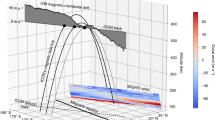Abstract
IN the course of experiments on atmospherics carried out for the Radio Research Board, it has been found that many of these disturbances include a semipermanent net change of the earth's potential gradient of the order of 0.1 volt per metre. It is natural to consider this change of field as representing the electrostatic effect of the thundercloud, the discharge of which causes an atmospheric. Measurements of the sign and magnitude of this change of field have been made by observing the alteration of the total electric charge on an exposed aerial system of high capacity (cf. C. T. R. Wilson, Proc. Roy. Soc. A, vol. 92, p. 555, 1916). It is estimated that these observations were made at least 200 kilometres from the thundercloud in question, in which case we may be fairly certain that the sign of the electric field change is indicative of the sign of the total electric moment destroyed in the discharge. It is found that the field changes in question are predominantly of one sign, representing the destruction of a field directed towards the earth. The ratio of the number of field changes of this sign to those of the opposite sign so far observed is about 300 to 1.
This is a preview of subscription content, access via your institution
Access options
Subscribe to this journal
Receive 51 print issues and online access
$199.00 per year
only $3.90 per issue
Buy this article
- Purchase on Springer Link
- Instant access to full article PDF
Prices may be subject to local taxes which are calculated during checkout
Similar content being viewed by others
Rights and permissions
About this article
Cite this article
APPLETON, E., WATT, R. & HERD, J. Rapid Variations of the Earth's Potential Gradient. Nature 113, 237–238 (1924). https://doi.org/10.1038/113237b0
Issue Date:
DOI: https://doi.org/10.1038/113237b0
Comments
By submitting a comment you agree to abide by our Terms and Community Guidelines. If you find something abusive or that does not comply with our terms or guidelines please flag it as inappropriate.



